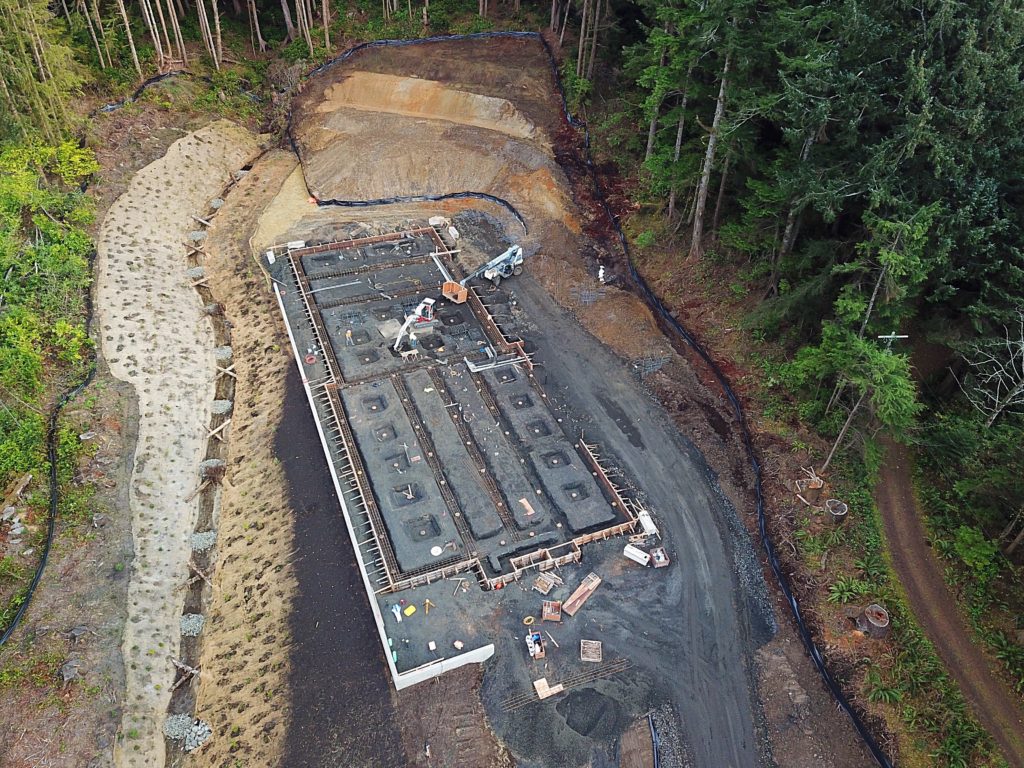
By QUINTON SMITH/YachatsNews.com
Problems with the site of the Yachats Rural Fire Protection District’s new $8.3 million station along U.S. Highway 101 have forced the district to make dozens of changes to the project to keep it within budget.
The 10,000-square foot station is being built on six acres on the north edge of Yachats with proceeds from a bond approved by voters in 2016. It is the most expensive public building project in Yachats’ history.
Despite the problems, Fire Chief Frankie Petrick says the station is still on schedule to open in December, replacing the two-story, 69-year-old station in downtown Yachats.
After a two-year search, the district bought the bulk of the land from a former fire chief and his brother in 2015 for $413,000. Two small, adjacent lots cost another $10,000.
The $174,000 first phase started last May when a contractor prepared the land for construction and the land cleared of timber. That included a state requirement to build a large detention pond at the front edge of the property to prevent runoff from reaching the highway.
Problems popped up as soon as the $6.5 million second phase started.
The first issue was a small creek on the north edge of the long, rectangular-shaped property. Although the district knew it was there, state and federal regulations required re-routing the creek to the north of the station. Permits, studies and hiring a special contractor to do the work cost an estimated $350,000, according to board member Ed Hallahan.
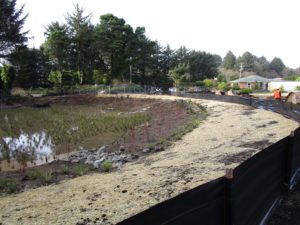
Contractors also had to move more land than expected to level the slope at the rear of the property where the station sits and bring in more rock than planned to use as fill, Petrick said.
But the biggest setback came when engineers found cracks in basalt that was supposed to support the station’s massive concrete slab and a layer of sand below it that would liquefy in a strong earthquake. It wasn’t until a second soil test – the district had already done initial soil tests — that engineers found the problem layer of sand. To solve that issue contractors had to drive 109 steel pilings to anchor the slab into a more stable layer of rock and redesign the foundation. The revised slab took 410 yards of concrete to complete
Those problems and resulting changes cost $506,000, according to figures compiled by the district and Pivot Architecture.
Although the bulk of construction problems can be traced back to the site, Hallahan believes it’s still the best location for the station because it was so difficult to find a large enough piece of property out of the tsunami zone that met insurance requirements for distance to Yachats-area homes and highways.
“It’s not like a piece of land in the valley that may be flat, dry and you know what’s there because it’s been used for something else previously,” he said. “We’re not blowing through money. We’ll control costs and get a building that works.”
The biggest problems are likely behind them, Hallahan told the board at its regular monthly meeting Wednesday. The slab was finished in December and now walls, trusses and beams for the station are going up.
“It’s going to calm down,” Hallahan said Wednesday.
The land purchase
But the purchase of the property from a former fire chief raised some eyebrows.
Hallahan and fellow board Katherine Guenther – who was in real estate at the time – volunteered in 2012 to begin scouting land for a new station. They would go look at property when they heard of or saw something that might be promising. Hallahan said they evaluated 10-20 sites before writing an April 2014 memo that listed four properties and ranked them in order of desirability.
Land owned by former fire chief Steve Hamilton of Yachats and his brother, Robert Hamilton, of Springfield ranked No. 1. The memo said while the 5.3-acre property was not listed for sale, it was outside the tsunami zone, met insurance location conditions, had excellent highway access and good sightlines. But the memo also stated “We are well aware of the potential for the appearance of conflict of interest if this land were to be acquired, and have considered ways to mitigate this.”
Hamilton has a long history with the Yachats fire department. He and Petrick were married for a few years before divorcing in 1983 and are neighbors in the Yachats River valley. Hamilton joined the fire department in 1964 and twice served as fire chief, the last time until 1993. Hamilton is still president of the South Lincoln Ambulance Company; Petrick is secretary. The nonprofit allows Yachats crews to use its lone vehicle to provide ambulance service to south Lincoln County and is reimbursed for its use.
Over the years Steve Hamilton invested in numerous properties in the Yachats area.
Once the Hamilton property was viewed as potentially the best site, Hallahan said the board insulated Petrick from the selection process. Hallahan said Guenther contacted Steve Hamilton about the district’s interest and in November 2014 Hamilton came to a board meeting to say the property was for sale.
The board got an outside appraisal on the Hamilton brothers’ property – which consisted of six residential parcels – which valued them at $380,000. In August 2015 agreed on a 5-year contract of $413,000.
Hallahan said the board made an “above the table” offer.
“We are comfortable we handled it cleanly,” he said.
Making changes
Issues with the site are forcing the district to stay within budget by trimming back or changing the fire station itself.
Late last May, when the district became concerned at cost projections, it asked Phase II contractor DSL Builders of Salem to suggest cuts. It came back with a list of 21 possible changes to save $316,000.
The district considered moving the station toward the front of the property to save money on land preparation. But Petrick said that would have put it back in a tsunami zone. The district used a study by the College of William & Mary in Virginia to precisely locate the station based on the projected size of tsunamis — forcing it to the rear of the site.
To save another $287,000 the district decided to postpone, for now, a separate storage building behind the main station. Siding of the station changed from cedar to Hardie board, open wood beams were redesigned, roads, driveways and parking lots went from concrete to asphalt, and lighting and landscaping were scaled back.

Cabinetry will now come from the Oregon Department of Corrections’ Prison Industries, Petrick said, and the district is looking at changing some flooring to save money.
The bond was supposed to pay for a generator to power the building in case of an electrical outage; instead the district will seek a grant to buy it, Petrick said.
The district is spending $1.48 million for fees and permits, the architect, staff time, testing and the like. It has also set aside $430,000 as a reserve to pay for items it wants to add back and $507,000 as construction contingency.
“We can’t go over because we don’t have the money,” Petrick said, and the district doesn’t have extra funds in its yearly operating budget to make up any difference. “We will continue to look at ways to trim back as we go along the next year. But functionality wise, the building will be just fine.”
The old and new
The fire district opened its headquarters in downtown Yachats in 1950, one year after voters approved forming the district. The current building has been added onto three times but struggles to hold or park equipment and provide working and living quarters for seven full-time firefighter/paramedics.
But the main impetus for a new station was to get it out of the tsunami zone, Petrick said. The current station is 22 feet above sea level; the new station sits above 80 feet.
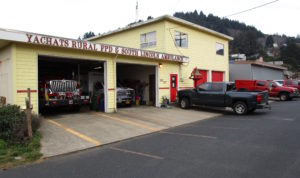
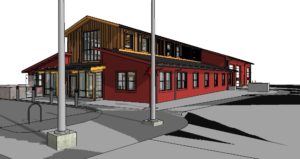
In addition to being out of the reach of most tsunamis, Petrick believes the new station will be a vast improvement over the current headquarters. It will have a public entry open around the clock, sleeping rooms for four employees, an office with four desks, big enough bays to hold a ladder truck the district hopes to eventually buy, a kitchen and dining area, day room, a meeting room and an exercise area on the second-floor mezzanine.
To help design the station, Petrick and administrative assistant Shelby Knife visited new fire facilities around the state to see what they liked and hear from others what did and didn’t work. The district contracted with Pivot Architecture of Eugene, which has experience designing fire stations.
Once the new station is open, Petrick said the district will put the current headquarters up for sale.
“We’ll just get it back on the tax rolls,” she said. “It’s served us well.”
A drawback of the new station, Petrick said, is that it will no longer be in the center of downtown and therefore will draw fewer visitors.
“One of the things we’ll miss is people will be less likely to stop in,” she said. “The new station is a bit off the beaten path.”
To help remedy that, Petrick said the district is thinking about offering regular open houses.
Weekly construction meetings
Most Tuesday mornings since construction started, Petrick, Knife and Hallahan meet at the job site or district headquarters to go over any problems, decision-making and scheduling with the lead architect, contractor and key subcontractors.
A Nov. 20 meeting, for example, was primarily focused on making changes to interior and exterior lighting.
“We’re kind of scraping for money here,” Hallahan reminded Pivot project director Jacky Gomez during one discussion.
After 45 minutes, the group found lighting changes expected to save $30,000.
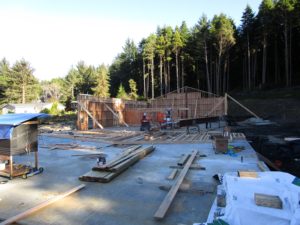
Gomez said the cost of the project has also risen because of Trump Administration’s new tariffs on steel, existing tariffs on lumber, rising prices for other material, and higher standards or requirements for public projects and first responders. Plus, she said, projects on the Oregon coast require extra shipping and special material and construction techniques to withstand the weather.
“With most big, public projects you’re not going to get everything you want,” Gomez said, “but you should get more than you expected.”
Knife said the district is keenly aware of keeping the project on track and within the budget.
“Ultimately we’re responsible to district patrons,” he said. “We don’t want to over-commit and end up with something we can’t afford in the end.”



